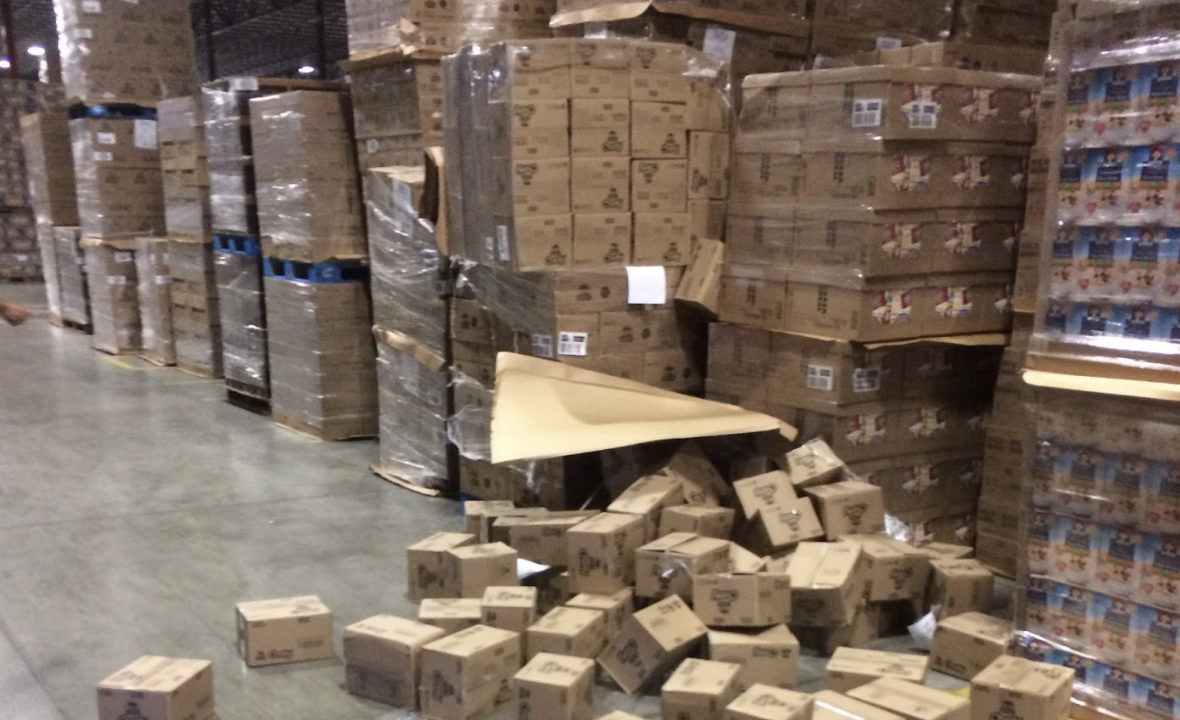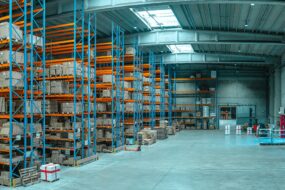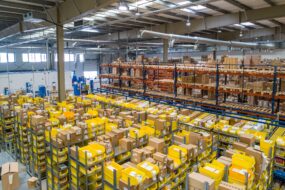Contents

Food warehousing is a critical part of the food supply chain, responsible for storing, handling, and distributing food products. The safety and quality of food products can be compromised if proper storage practices are not followed, which can lead to considerable repercussions for both the customer and the business running the food warehouse. As one example, I’ve personally witnessed $1.2 million in food-grade products written off a company’s books from damaged goods, expired products, and lost inventory because of improper processes within a food warehouse.
In this article, we will discuss the factors that affect food storage, essential tips for safe and efficient food storage, best practices for food warehousing, and common mistakes to avoid.
Factors Affecting Food Storage
There are a variety of factors that affect food warehousing and storage, but there are 4 main considerations.
Temperature
Temperature is one of the most critical factors affecting food storage. Different foods have different temperature requirements for safe storage. For example, perishable foods such as dairy, meat, and produce require a lower temperature to prevent bacterial growth and spoilage. Frozen foods require even lower temperatures to maintain quality and safety.
An additional consideration when controlling for temperature in food warehousing is the energy costs. Warmer clients will require additional energy to cool food warehouses. One opportunity that’s lesser known is using warehousing space in the old limestone mines of Missouri. Springfield, MO hosts 3.2 million square feet of food warehousing space called the Springfield Underground which naturally has cooler temperatures. The advantage is lesser energy costs because it’s below ground, doesn’t go higher than 65 degrees year around, and it’s not exposed to natural disasters.

Humidity
Humidity is another essential factor to consider when storing food. High humidity can cause mold growth and spoilage, while low humidity can cause dehydration and loss of quality. It is essential to maintain optimal humidity levels for different types of food products.
Another consideration with humidity is how it affects your food’s packaging. Humidity means high moisture content which can degrade the structural integrity of the packaging. If the structural integrity is affected enough, pallets can fall over causing workplace hazards.
Light
Light exposure can affect the quality and safety of food products. Exposure to light can cause oxidation and degradation of nutrients, flavor, and color. It is critical to store food in opaque containers or in areas where there is no exposure to light.
Some foods that are especially sensitive to light exposure include dairy which can break down riboflavin causing the flavor to be off. Another example is leafy greens which can lose nutritional value and a loss of quality from exposure to light.
Ventilation
Proper ventilation is also important for maintaining the quality and safety of food products. Poor ventilation can cause moisture buildup, which can lead to mold growth and spoilage. This can shut down a warehouse’s operations overnight.
Another consideration is the gases given off by certain fruits. As an example, bananas ripen much more quickly when exposed to ethylene, which is why their stems are often wrapped to prevent it and separated from other fruits within a food warehouse.
Tips for Safe and Efficient Food Storage
The actual storage of food is paramount to keeping its quality and efficient movement within a food warehouse.
Proper Food Handling
All food products should be handled with care and stored in the appropriate conditions. Food handlers should follow hygiene practices such as washing hands, wearing gloves, and using clean utensils if they come in direct contact with food.
If a food warehouse wants to take its handling of products one step further and give a level of confidence to its customers, it can apply for certification from a company like AIB. It’s an incredibly rigorous process that I’ve personally assisted with getting facilities their certification. The company can show up at any time to audit facilities against the guidelines that are best-in-class for food-grade warehousing. If you are a food distributor, it can be the vote of confidence that a customer needs when selecting from other competitors.
Correct Storage Containers
Using the correct storage containers is important, too. The containers should be food-grade and designed for the type of food being stored. Glass, plastic, and metal containers are commonly used for food storage. It is essential to label the containers with the date and contents for easy identification for both the customer and warehouse staff.
Organization and Inventory Management
Proper organization and inventory management are essential for efficient food storage. Food products should be organized based on their storage requirements, with those that require colder temperatures stored in the coldest areas of the warehouse. It is critical to keep a record of inventory levels to ensure that there is enough stock and prevent overstocking.
Typically, bigger companies like Kraft Heinz and food distributors will have sophisticated planning models to manage inventory and prevent overstocking using ERP systems like SAP. Smaller merchants can use inventory management tools like Cogsy to prevent overstock. Additional technology a Food warehouse will want is a robust WMS system like Manhattan.
Pest Control
Having a mouse or a cockroach come out of a trailer sent from one of your food warehouses to a customer warehouse isn’t a good look, and I’ve seen it happen. Customers can completely shut down shipments from a facility when this happens, thus; stopping all activity at the food warehouse.
Pests such as rodents, insects, and birds can contaminate food products and cause damage to the warehouse. Implementing pest control measures such as sealing cracks and crevices, using bait stations, and monitoring the warehouse for signs of pest activity is essential.
Safety and Sanitation
Safety and sanitation are critical for food storage. The warehouse should be kept clean and free of debris, and spills should be cleaned up immediately to prevent slips and falls. Allowing spills and debris to remain as is can contribute to a workplace culture that accepts it as everyday business.
Best Practices for Food Warehousing
There are a variety of best practices for food warehousing. These are the best in my 10 years of experience operating them.
Rotation System
Implementing a rotation system is one of the best practices for food warehousing. A rotation system ensures that the oldest products are used first, preventing spoilage and waste. One of the biggest misconceptions in food warehousing is setting up the rotation of your inventory on a FIFO (First-In-Firt-Out) basis instead of FEFO (First Expired, First Out). Oftentimes, a shipment may arrive on May 1st with an expiration date of November 1st, but a shipment with the same exact product can arrive 2 weeks later, on May 14th, with an expiration date of August 1st. In other words, shipments with the same SKU can arrive after one another with an earlier expiration date. Using the FEFO method mitigates any food product expiring because the oldest products are used before the newer ones.
Storage System Design
The design of the storage system can also affect the safety and efficiency of food storage. The storage system should be designed to optimize space and labor, and ensure easy access to all products. It is essential to consider factors such as the size of the products, the weight capacity of shelves and racks, and the aisle width for easy movement.
Some of the most common configurations I’ve personally experienced in my career are ABC organization in a racked food warehouse where the fasted movers are on the A level (or bottom level). Other configurations include zone picking, a flying-V configuration, or random storage which Amazon utilizes and is best used if a warehouse’s system is set up to interleave (another article should be written about interleaving). At the end of the day, it really depends on the unique needs of your food warehouse and the capabilities of your WMS system (another article about this).
Automation & Software
Automation can also improve the safety and efficiency of food warehousing. Automated systems such as conveyor belts, palletizers, and robots can reduce manual labor, increase efficiency, and reduce the risk of accidents. Automated systems can also provide real-time data on inventory levels and other critical information.
In my experience and one of the ways I’ve seen automation is that we used Laser Guided Vehicles (LGVs), which replaced the need for forklift drivers. They drive around on a virtual track taking pallets off the manufacturing line and placing them in the food warehouse. While they are capital-intensive and best structured on a lease agreement, they can save immensely on labor costs.
Common Mistakes to Avoid
Many 3PLs and food warehouses upon start-up are prone to mistakes. Here are the most common ones and how to avoid them.
Overstocking
Overstocking is a common mistake that can lead to food waste and loss of revenue. Overstocking can also lead to the storage of products in inappropriate conditions, leading to spoilage and safety concerns.
As a past supply-chain consultant, an operator at a Fortune 500 company, and managing inventory for my clients at Outbound Fulfillment, this can make or break brands. I have seen up to 20% of a SKUs inventory be written off because of overstocking from low demand. Furthermore, overstocking creates additional working capital on the books that could be used for other core-business activities.
Inadequate Inspection and Maintenance
Inadequate inspection and maintenance can also compromise the safety and efficiency of food storage. It is essential to inspect the storage area regularly for signs of damage, wear, and tear. The equipment should also be maintained regularly to ensure optimal performance.
An example in my experience of inadequate inspection that affected efficiency in food warehousing was the lack of adherence to Preventative Maintenance (PMs) (probably another article about this one) on forklifts and relevant equipment. One example is 5 forklifts from our 3PL that went down for repairs during the busiest day of the year due to the lack of proper maintenance of them in the off-season. This 3PL had to go out and rent forklifts to adequately fulfill orders as they came through, which was an additional cost to them.
Poor Staff Training
Poor staff training can also affect the quality of products and efficiency within a food warehouse. One example of poor training is the amount of damaged product I saw at a food warehouse shipping cereal because of their slip sheet operators punching holes through boxes because they were not properly trained to pick up food that came in on slip sheets. (Need an article on “What platforms to move product or freight: slip sheets, IGPS, Whitewood, CHEP, etc.”; or something like that)
Staff should be trained on proper handling and storage techniques, safety guidelines, and equipment operation. Regular training sessions can help improve staff performance and reduce the risk of accidents.
Lack of Monitoring and Control
It is important to monitor the warehouse regularly for temperature, humidity, and other critical factors. Real-time data can help identify potential issues and prevent spoilage and safety concerns.
If there are no safeguards in place for environmental factors that can affect your food, it can become susceptible to spoilage or degradation in quality.




